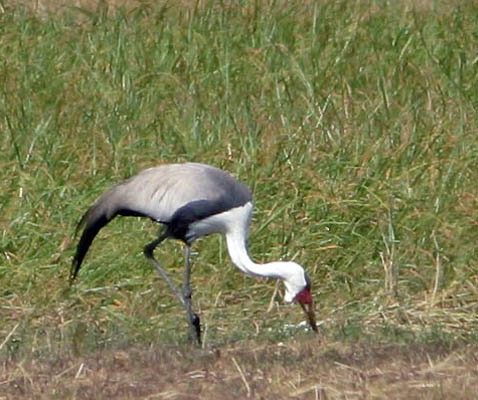
a web page by Don Roberson |
 |
||
CRANES Gruidae |
||
|
||
The center of crane diversity is northeast Asia, among them Black-necked Crane (left; note its size to a Snowy Plover). Black-necked is almost a China endemic, with breeding centered on high elevation lakes on the Qinghai–Tibetan Plateau. Birdlife International (2000) estimates its world population at just 5600–6000 birds. On a 2004 trip we were told in advance that our views of would be very distant. This was true but for a pair along the shoreline of a freshwater lake next to Qinghai Lake. On our final morning the light was great and the reflections were fabulous (left; at the time it was a crisp 40 degrees F). |
||
In 2002, a friend loaned me Peter Matthiessen's The Bird of Heaven: Travels with Cranes. Matthiessen's word pictures on searching out all the cranes in the world were vivid and compelling, and none more so than the northeast Asian species. Although a trip to China was well down the list of places I hoped to visit at the time, after reading the book I began searching the web for bird tours to eastern Asia that might net some of the scarcest and most remote species. I settled on a Sunbird tour of north China, led by Paul Holt, that promised reasonable shots at three of the five species possible. Our first site for cranes was Xianghai National Nature Reserve in Jilin Province, northeast China. This is the region often called Manchuria, although this Japanese term is not used by the Chinese. We reached the reserve via a 12-hour train trip from Beijing, and then a long drive. Distances in China are vast and the reserve rather remote. The reserve has suffered from a 6-7 year drought and many breeding marshes were now entirely dry. Long, multi-hour drives over deep sand and bitterly rutted roads in 4-wheel drive jeeps took us to the very remaining wet spots. At the first area — a huge grassland — no cranes were initially present, but eventually a pair of Red-crowned Crane appeared in the distance, and one flew closer for this view (below; alas all photos from this China trip are digiscoped shots). |
||
 |
||
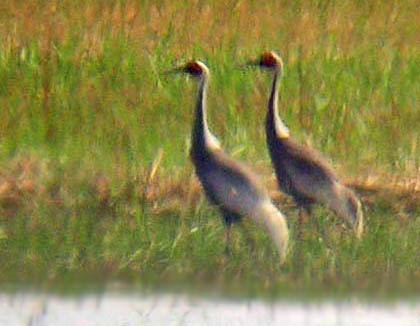 Red-crowned Crane is often called "Japanese Crane" because it is the species that breeds on Hokkaido, Japan, and is famous from the dancing cranes often seen in film. Birdlife International (2000) lists it as an Endangered species with three isolated populations: Japan (~600 birds), Korea (~400 birds), and northeast China (~1200 birds) — only ~2200 birds remaining and these in decline. Red-crowned Crane is often called "Japanese Crane" because it is the species that breeds on Hokkaido, Japan, and is famous from the dancing cranes often seen in film. Birdlife International (2000) lists it as an Endangered species with three isolated populations: Japan (~600 birds), Korea (~400 birds), and northeast China (~1200 birds) — only ~2200 birds remaining and these in decline. The crane that I most wanted to see, however, was White-naped Crane (right). I think it may be the most elegantly beautiful of all the cranes. We found only one pair — late in the morning after hours and hours of searching at Xianghai — and views were fairly distant (right). This crane prefers wetter habitats than the grasslands frequented by Red-crowned Crane, and thus seemed to be even more affected by the drought . The species breeds patchily from eastern Mongolia to southern Siberia, and winters at specific sites in eastern China, in Korea (demilititarized zone), and in Japan. The world population is 5500 to 6500 birds and declining; it is considered Vulnerable (Birdlife International 2000). |
||
| Five of the world's 15 cranes are in the genus Grus: the tall, stately, and retiring cranes of our dreams. The rarest is the huge Whooping Crane (below left, in a beautiful shot © Greg W. Lasley). Until satellite populations were recently established, the entire population bred only in one remote park in central Canada and migrating each winter to the Texas coast at Aransas NWR. At the turn of the 21st century the world population was counted at 183 birds (Birdlife International 2000). This is almost twice what is was in 1980, and the population has continued to grow in recent years. | ||
|
||
| Sadly, though, the champion distance migrant, and the most endangered of all cranes, is the huge, red-faced Siberian Crane (above right, in a photo © Bhoulu Khan). Its estimated numbers were once higher than Whooping (perhaps 2500 birds; Birdlife International 2000) but it is the crane most dependent on remote taiga marshes without any human disturbance. It has three widely separated populations: the western, which winters in Iran and is virtually extinct; the central, which winters at Bharatpur, Rajasthan, India (where above photo was taken several decades ago). This central population has declined from several hundreds in the 1960s to less than ten in recent estimate. It is the eastern population , which winters along the middle Yangtze River in s. China, that has the bulk of the global population. The photo of these two Siberian Cranes is by Bhoulu Khan, who was once the head forester at Keoladeo Ghana reserve, known as Bharatpur, a series of artificial marshes in the plains of India where these birds used to winter regularly. The cranes travel in very small groups over a route of 3100 miles. As Matthiessen (2001) notes, the loss of this population would be the loss of millions of years of knowledge. Only adult wild cranes can teach young how to make this incredible journey. On our visit there in March 2001, we were already too late for the two Siberian Cranes that had wintered that year. One of our nights there, Bhoulu Khan put up a bed sheet outside on the patio and showed us his amazing photos of the park, including this shot. To my personal amazement, Bhoulu is the son of the former head cook at the rest house at Bharatpur, where I had stayed 23 years before (in 1978). It was his father that first served me real Indian food, sparking a life-long interest in that vegetarian cuisine! [In a longer story that I can't tell now, it is because of Indian food that I met my wife.....]. |
||
|
||
| Most northern hemisphere cranes are highly migratory, and the sight of a flight of cranes overhead can be awe inspiring. The photos (above) are snapshots of those migrant cranes: a flock of Sandhill Crane in California's Central Valley in winter (upper above), and a smaller flock of spring migrant Demoiselle Crane in the dry Great Indian desert, elegantly searching for a bit of sustenance in the barren earth (just above). Cranes have a mystical hold on many people. I am influenced by this power. They do speak to me of vast wilderness, even though these days they are mostly encountered in agricultural stubble next to a central California freeway. But they belong to the wild. | ||
In Asia, Common Crane Grus grus undertakes long migratory flights, as do five species of endangered cranes: Siberian, White-naped, Black-necked, Red-crowned, and Hooded G. monacha. Cranes have many fascinating features. They tend to mate for life and can be tenacious in defense of their pair bond. Their stereotypic head–bowing and back–arching displays, and bugled calls, cement these bonds. Better yet, they dance! As the displays pick up — often on the wintering grounds — they perform ballet leaps of extraordinary beauty. The Red-crowned Cranes wintering in Japan are famous for their "dances in the snow." And then there are the southern hemisphere and tropical cranes. In south Asia there is Sarus Crane Antigone antigone, which has an isolated subspecies in northeastern Australia. It is has had serious declines in Asia. More widespread in Australia is Brolga (right, standing in the arid center of Australia), which has an isolated population in southern New Guinea (below; a pair of Brolga with nearly full-grown youngster staring out over their domain: an expanse of a southern New Guinea seasonal wetland). |
||
 |
||
Wattled Crane (below left) is an endangered and declining resident of local wetlands from the Ethiopian highlands to the Okavango delta. Most of the population uses large wetlands on riparian floodplains, primarily in the Kafue, Zambezi and Okavango river basins. Not only does it have an unusually wattled bare-red face and a white neck, its inner secondaries are exceptionally long, reaching well beyond the tail. Heavily dependent on wetlands, it often undertakes local migratory movements during the dry season. Blue Crane (pair, below right) is a lovely grassland crane very patchily distributed in southern Africa. It and Demoiselle Crane are the only crane with fully-feathered heads, but the loose feathering on the head of Blue Crane produces a unique "cobra" appearance. The secondaries are exceedingly long and almost reach the ground. |
||
|
||
Each species of crane has much history and many stories. Fortunately for us, these are now woven together in Peter Matthiessen's marvelous book The Birds of Heaven: Travels with Cranes (2001). I highly recommend it as an insightful and powerful wildlife read. The novel-like book is illustrated by Robert Bateman. I have long considered Bateman among my favorite bird artists, but what I have admired most are his "landscapes with birds." Cranes would be perfect for such a treatment, but none of them appear here (his Wattled Crane painting is the closest he comes to a landscape in this book). Rather, we have close-ups of the heads of all species, and we have close-up vignettes of all the cranes — often wreathed in mists — with only bits of landscape. This is not classic Bateman. The head details appear accurate but it is not nearly as evocative as his artistry usually is to me. Still, Matthiessen's word pictures are superb. |
||
Photos: The Gray Crowned-Crane Balearica regulorum was in flight over Ngorongoro Crater, Tanzania, on 11 June 2018. The Black-necked Crane Grus nigricollis (with a Snowy Plover) was near Qinghai Lake, China, on 4 June 2004. Both the Red-crowned Crane Grus japonensis and the pair of White-naped Crane Antigone vipio were at Xianghai Nature Reserve, Jilin, China, on 13 June 2004. Greg W. Lasley photographed the Whooping Crane Grus americana in Aransas NWR, Texas, on 19 Feb 2001. Bhoulu Khan photographed the two Siberian Crane Leucogeranus leucogeranus at Bharatpur, Rajasthan, India, in the 1990s. The flock of Sandhill Crane Antigone canadensis was at Tulare NWR, California, on 1 Feb 2020. The migrant party of Demoiselle Crane Anthropoides virgo was in the Great Indian Desert, east of Jaisalmar in w. Rajasthan, India, in March 2001. The lone Brolga Antigone rubicunda was far out the Birdsville Track, South Australia, on 21 Nov 2009; and the family group of Brolga were in Wasur NP, Papua, Indonesia, in southern New Guinea, on 10 Aug 1004. The family group of Gray Crowned-Crane Balearica regulorum was in Tarangire NP, Tanzania, on 9 June 2018. The Wattled Crane Bugeranus carunculatus was in Mahango Game Reserve, Namibia, on 23 July 2005. The pair of Blue Crane Anthropoides paradiseus was near Wittewater, South Africa, on 5 July 2005. All photos © Don Roberson, except those credited © Greg W. Lasley and © Bhoulu Khan, and used with permission; all rights reserved. Family book:
Family book:
Literature cited:
|
 The Gruidae is a fairly small (15 species) family of large impressive birds of open country — places like marshes, grasslands, or tundra that go on forever. They are evocative of the last wild and open places left on earth. As those places become fewer and smaller, it is not a surprise that 9 species (60% of all crane species) are declining and considered endangered, threatened, or vulnerable (Archibald & Meine 1996). Those species that still remain reasonably common are spectacular, such as a Gray Crowned-Crane (above) in flight over Ngorongoro Crater in east Africa.
The Gruidae is a fairly small (15 species) family of large impressive birds of open country — places like marshes, grasslands, or tundra that go on forever. They are evocative of the last wild and open places left on earth. As those places become fewer and smaller, it is not a surprise that 9 species (60% of all crane species) are declining and considered endangered, threatened, or vulnerable (Archibald & Meine 1996). Those species that still remain reasonably common are spectacular, such as a Gray Crowned-Crane (above) in flight over Ngorongoro Crater in east Africa.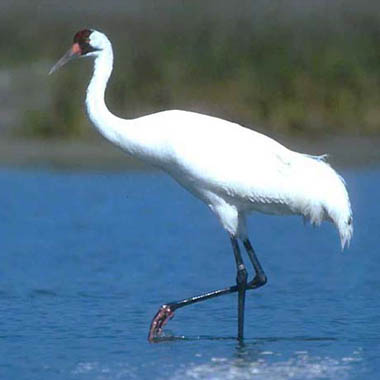
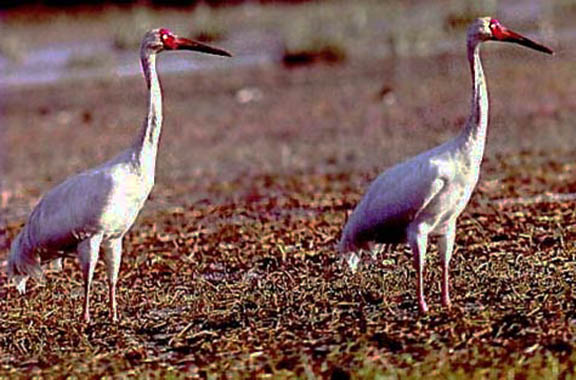


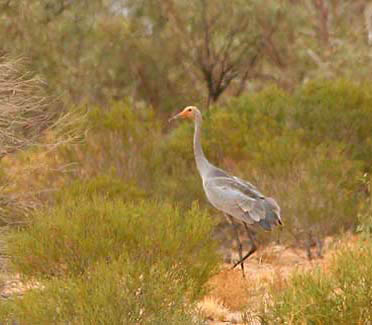
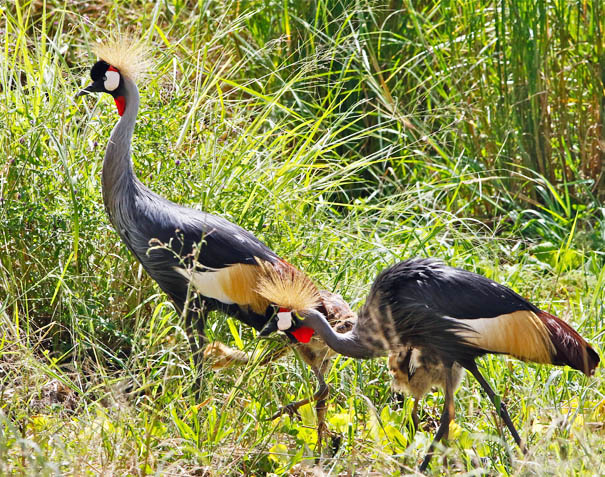 Finally, there are four African cranes. Two are marvelous crowned-cranes: Gray Crowned-Crane (flight photo at top of page, and also left, a pair with two young) and Black Crowned-Crane Balearica pavonina. Gray Crowned-Crane is an African wonder and one of the few birds tourists really want to see while searching for the "big five" mammals in the parks of east and south Africa. The bird appears on national stamps and money. In many areas there are recent declines with loss of wetlands, although local cultural traditions of reverence have provided protection. Black Crowned-Crane is the replacement species in the Sahel region, south of the Sahara but north of tropical forests.
Finally, there are four African cranes. Two are marvelous crowned-cranes: Gray Crowned-Crane (flight photo at top of page, and also left, a pair with two young) and Black Crowned-Crane Balearica pavonina. Gray Crowned-Crane is an African wonder and one of the few birds tourists really want to see while searching for the "big five" mammals in the parks of east and south Africa. The bird appears on national stamps and money. In many areas there are recent declines with loss of wetlands, although local cultural traditions of reverence have provided protection. Black Crowned-Crane is the replacement species in the Sahel region, south of the Sahara but north of tropical forests.